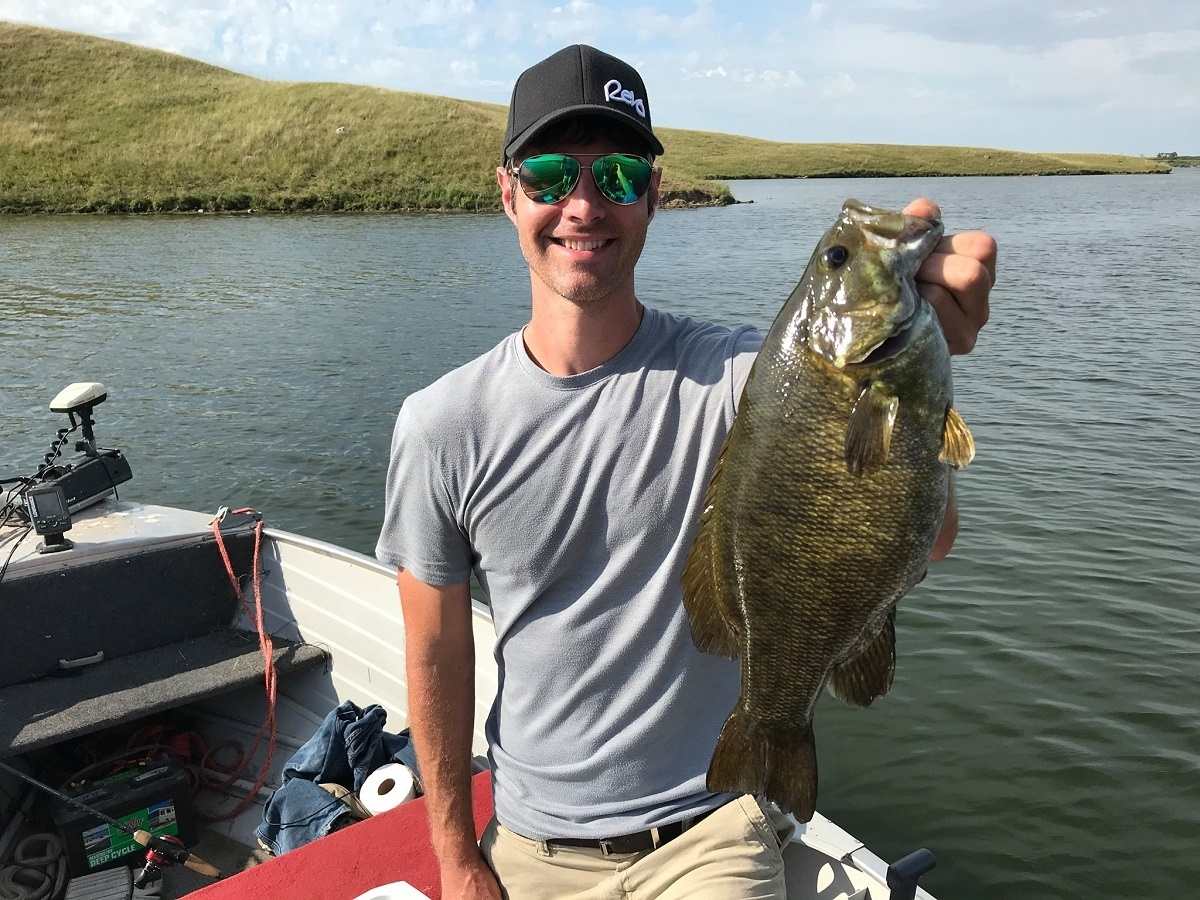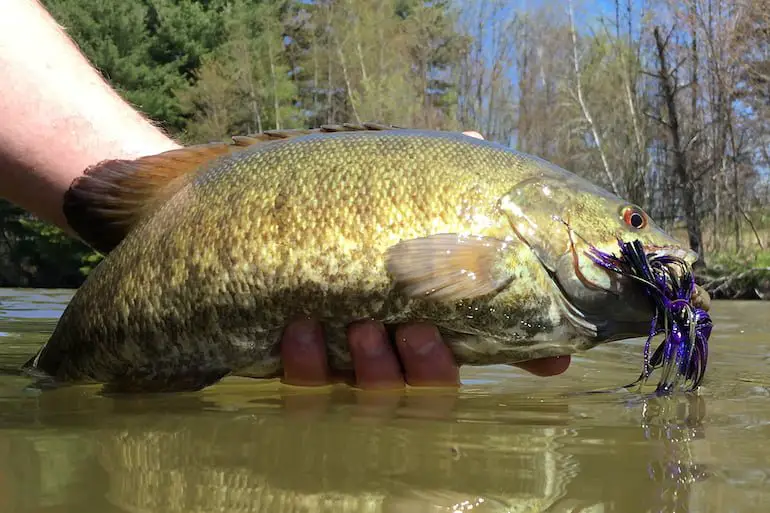Are you an avid angler looking to make the most of your river fishing trips? If so, then understanding the spawning patterns of smallmouth bass is crucial. Knowing when these prized fish reproduce in rivers can greatly enhance your chances of a successful fishing outing. In this article, we will explore the timing of the smallmouth bass spawn in rivers, equipping you with the knowledge you need to reel in your catch of a lifetime. So, grab your fishing gear and get ready to discover the secrets of when these bass spawn in rivers!

Factors Affecting Smallmouth Bass Spawning
Smallmouth bass spawning is influenced by several factors that play a crucial role in determining the timing and success of the reproductive process. These factors include water temperature, photoperiod, habitat availability, and pre-spawn behavior. Understanding these factors can help anglers and researchers gain insights into the spawning patterns of smallmouth bass.
Water Temperature
Water temperature is one of the most important factors that triggers smallmouth bass spawning. Smallmouth bass typically spawn when the water temperature ranges between 60 to 65 degrees Fahrenheit (15.5 to 18.3 degrees Celsius). As the water warms up in spring, it signals the smallmouth bass to begin their spawning activities.
Photoperiod
The duration of daylight, also known as photoperiod, is another significant factor influencing smallmouth bass spawning. Longer daylight hours during the spring months provide the necessary cues for smallmouth bass to initiate their reproductive behaviors. As the days become longer, the smallmouth bass can sense the changing photoperiod, which signals the arrival of the spawning season.
Habitat Availability
The availability of suitable spawning habitats greatly affects the smallmouth bass spawning process. Smallmouth bass require specific features in their nesting substrate, including gravel or rocky bottoms. These structures provide a stable foundation for their nests, where the eggs are laid and guarded by the male bass. Additionally, suitable cover such as fallen trees or submerged vegetation in close proximity to the nests is crucial for protecting the eggs and fry.
Pre-spawn Behavior
Before spawning, smallmouth bass exhibit distinct pre-spawn behaviors that prepare them for successful reproduction. During this period, smallmouth bass focus on feeding heavily to build up energy reserves. They become more aggressive and engage in territoriality, marking their nesting sites and defending them against intruders. Courtship displays between the male and female bass also occur, where they perform elaborate movements and fin displays to attract mates.
Timing of Smallmouth Bass Spawning
The timing of smallmouth bass spawning can vary based on geographical factors, seasonal differences, water levels, and even the spawning behavior observed during different times of the day.
Geographical Variation
Smallmouth bass spawning time can vary depending on the geographical location. In general, smallmouth bass spawn earlier in the south compared to the north. This variation is influenced by temperature differences, as southern regions experience warmer temperatures earlier in the year, triggering spawning activities. Conversely, in northern regions, smallmouth bass may spawn later due to cooler water temperatures.
Seasonal Differences
Within each geographical region, seasonal variations can also impact the timing of smallmouth bass spawning. Early spring spawning is observed when water temperatures gradually warm up after the winter season. Late spring spawning occurs when the water is at its warmest, providing optimal conditions for successful reproduction. These seasonal differences take into account variations in weather patterns, which directly influence water temperature.
Water Level and Flow
Water levels and flow rate in rivers also play a role in determining the timing of smallmouth bass spawning. Ideal water levels during the spawning period are crucial to provide the necessary habitat conditions for successful reproduction. Flooding events can disrupt spawning activities by washing away nests and compromising the survival of eggs and fry. Conversely, drought conditions can reduce water levels, making it difficult for smallmouth bass to find suitable nesting sites.
Daytime vs Nighttime Spawning
Smallmouth bass can exhibit different spawning behaviors based on the time of day. They are known to spawn during both daylight and nighttime hours, depending on various factors. Spawning behavior during the daytime provides better visibility for anglers and researchers to observe the process. Nocturnal spawning behavior may be favored in areas with high fishing pressure during the day, allowing the bass to spawn undisturbed.

Water Temperature as a Spawning Cue
Water temperature serves as a critical spawning cue for smallmouth bass. The preferred temperature range within which smallmouth bass initiate their spawning activities is around 60 to 65 degrees Fahrenheit (15.5 to 18.3 degrees Celsius). This range provides optimal conditions for successful egg development and fry survival.
Effects of Cold Snaps
Cold snaps or sudden drops in water temperature can significantly impact smallmouth bass spawning. If the water temperature falls below the preferred range, it can delay or disrupt the spawning process. Smallmouth bass may exhibit delayed nesting activities or abandon their nests altogether due to unfavorable conditions. However, if the cold snap is temporary and followed by a return to suitable temperatures, spawning activities may resume.
Effects of Warm Spells
Conversely, warm spells can also influence smallmouth bass spawning. A sudden increase in water temperature, especially if it surpasses the optimal range, may accelerate the spawning process. This can lead to early or premature spawning, which poses a risk to the survival of the eggs and fry. Smallmouth bass rely on synchronized spawning to maximize the survival of their offspring, so any disruptions to this timing can have consequences.
Importance of Photoperiod
Photoperiod, or the length of daylight, plays a crucial role in smallmouth bass spawning. As the days become longer during the spring months, the changing photoperiod acts as a cue for smallmouth bass to initiate the reproductive process.
Length of Day
The duration of daylight triggers hormonal changes in smallmouth bass that are necessary for successful spawning. Longer days indicate the arrival of spring and signal to the bass that it is the optimal time to reproduce. As the photoperiod lengthens, it stimulates the production and release of reproductive hormones, thereby initiating spawning behaviors.
Effects of Daylight Intensity
In addition to the length of the day, the intensity of daylight also influences smallmouth bass spawning. Bright, sunny days with high levels of light intensity can further stimulate the reproductive hormones and accelerate the spawning process. The combination of longer daylight hours and increased light intensity create ideal conditions for smallmouth bass to begin their reproductive activities.

Habitat Requirements for Spawning
Smallmouth bass have specific habitat requirements for successful spawning. These requirements include nesting substrate, water depth and clarity, flow velocity, and proximity to cover.
Nesting Substrate
Smallmouth bass require suitable nesting substrates to build their nests and lay their eggs. They prefer gravel or rocky bottoms, as these provide a stable foundation. The male bass excavates a nest in the substrate using its tail, creating a depression where the eggs are laid. Adequate nesting substrates are crucial for the protection and survival of the eggs.
Water Depth and Clarity
Ideal water depth for smallmouth bass spawning typically ranges from 2 to 15 feet. This depth provides the necessary protection for the nests while allowing sufficient water flow for oxygenation. Water clarity is also important since it affects visibility and the ability of the male bass to guard the nest and protect the eggs from predators.
Flow Velocity
Flow velocity of the water can impact smallmouth bass spawning. Moderate flow rates are generally preferred, as they provide adequate oxygenation and prevent debris buildup in the nests. High flow rates can wash away the nests, endangering the eggs and fry. Conversely, low flow rates can result in stagnant conditions, leading to decreased oxygen levels and potential egg suffocation.
Proximity to Cover
Smallmouth bass seek proximity to cover during spawning. Fallen trees, submerged vegetation, and other forms of cover provide protection for the nests and the newly hatched fry. These structures offer shade and refuge from predators, ensuring the survival of the offspring. The availability of suitable cover near the nesting sites greatly influences the success of smallmouth bass spawning.
Pre-spawn Behavior of Smallmouth Bass
Prior to spawning, smallmouth bass exhibit specific behaviors that prepare them for successful reproduction. These pre-spawn behaviors include feeding behavior, territoriality, and courtship displays.
Feeding Behavior
Smallmouth bass engage in intense feeding activity before spawning. They focus on consuming large quantities of food to build up energy reserves for the upcoming reproductive period. Anglers often take advantage of this feeding behavior, targeting smallmouth bass with lures and baits that mimic their preferred prey.
Territoriality
During the pre-spawn period, male smallmouth bass become territorial, marking and defending their nesting sites. They create circular depressions in the substrate, known as “beds,” which serve as nests. When other bass, including females, approach their territories, the male bass become aggressive and chase them away. This territorial behavior ensures that the nesting site remains secure.
Courtship Display
Courtship displays play a vital role in smallmouth bass reproduction. Male bass perform elaborate movements and fin displays to attract females and initiate the spawning process. These displays include vibrant coloration, fin flaring, and tail-slapping. The male bass also vocalize by producing low frequency “booming” sounds to communicate with the females. These courtship displays help pair up the male and female bass, leading to successful spawning.

Geographical Variation in Spawn Timing
Spawn timing in smallmouth bass can vary depending on the geographical location. Temperature differences between regions greatly influence when smallmouth bass initiate their spawning activities.
North vs South
In general, smallmouth bass spawn earlier in the south compared to the north. Southern regions experience warmer temperatures earlier in the year, allowing the water to reach the optimal spawning temperature range sooner. Therefore, smallmouth bass in the south may start spawning as early as late April or early May, while those in the north may delay spawning until late May or early June.
West vs East
Geographical variation in spawn timing is also observed between the west and east regions. Western states, such as California, experience milder winters and earlier spring temperatures, which can lead to earlier spawning. In contrast, eastern states, such as New York or Pennsylvania, often have colder winters, resulting in later spawning periods for smallmouth bass.
Seasonal Differences in Spawn Timing
Within each geographical region, seasonal variations can affect the timing of smallmouth bass spawning. Early spring and late spring spawning are two distinct periods observed in smallmouth bass reproduction.
Early Spring Spawning
Early spring spawning occurs as the water gradually warms up after the winter season. Typically, this period occurs in late April to early May, depending on the geographical location. Smallmouth bass take advantage of the increasing water temperature to initiate their reproductive activities. Early spring spawning can be influenced by factors such as warmer weather patterns and longer daylight hours.
Late Spring Spawning
Late spring spawning happens when the water reaches its warmest temperature, usually in late May or early June. The optimal water temperature range for successful reproduction, around 60 to 65 degrees Fahrenheit (15.5 to 18.3 degrees Celsius), is typically achieved during this period. Late spring spawning provides smallmouth bass with favorable conditions for egg development and fry survival, maximizing the reproductive success.

Water Level and Flow Effects on Spawning
Water levels and flow rate in rivers play a crucial role in smallmouth bass spawning. They can significantly impact the availability and suitability of nesting sites, ultimately affecting reproduction.
Ideal Water Levels
Ideal water levels for smallmouth bass spawning provide the necessary conditions for successful reproduction. These levels ensure that the nesting sites are submerged to the appropriate depth and that there is adequate water flow for oxygenation. The availability of suitable water depths is crucial for protecting the eggs from predators and preventing desiccation. Ideal water levels vary from river to river and depend on the specific nesting habitat requirements of smallmouth bass.
Effects of Flooding
Flooding events can disrupt smallmouth bass spawning activities. Excessive water levels due to heavy rain or dam releases can wash away nests, destroying the eggs and jeopardizing the fry’s survival. Floodwaters may also alter the flow velocity, increasing it to levels that are unsuitable for successful spawning. Smallmouth bass may need to find alternative nesting sites if their original nests are washed away, potentially delaying or disrupting the reproductive process.
Effects of Drought
On the other hand, drought conditions can also impact smallmouth bass spawning. Low water levels resulting from prolonged periods of drought may lead to decreased flow rates and stagnant conditions. In such situations, suitable nesting sites may become scarce, making it challenging for smallmouth bass to find suitable locations for reproduction. Reduced water availability can also concentrate smallmouth bass in smaller areas, increasing competition for limited resources and potentially affecting spawning success.
Daytime vs Nighttime Spawning
Smallmouth bass exhibit spawning behaviors during both daytime and nighttime hours, depending on various factors such as visibility, competition, and disturbance levels.
Spawning Behavior During Daytime
Smallmouth bass engage in spawning activities during daylight hours. The increased light during the day provides better visibility for observers, including anglers and researchers, to witness the spawning process. Daytime spawning behavior allows for detailed observations of courtship displays, nest building, and fry emergence. However, the increased presence of anglers and recreational activities during the day can cause disturbance and potentially disrupt the spawning process.
Nocturnal Spawning Behavior
Nocturnal spawning, or spawning during the night, is also observed in smallmouth bass. This behavior may be influenced by factors such as low light conditions, reduced competition from anglers, and increased protection from predators. Nocturnal spawning allows smallmouth bass to reproduce with minimal disturbances and potentially increase the survival rate of their offspring. However, it presents challenges for researchers and anglers who may have limited visibility during nighttime hours.
In conclusion, smallmouth bass spawning is an intricate process influenced by various factors such as water temperature, photoperiod, habitat availability, and pre-spawn behavior. Understanding these factors and the timing of spawning can provide valuable insights for anglers, researchers, and river management efforts. By considering these factors, we can enhance our understanding of smallmouth bass biology and contribute to the conservation and sustainability of smallmouth bass populations in rivers.




